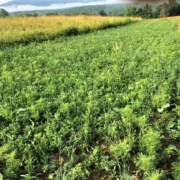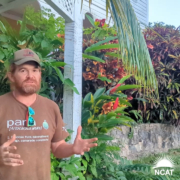Establishing Native Warm-Season Meadows Without Herbicides
 Print This Post
Print This Post
By Chris Lent, NCAT Agriculture Specialist
Planting a conservation cover of warm-season grasses and wildflowers on my property in Northeastern Pennsylvania was a great decision and has been very rewarding. I often observe rabbits and the foxes and hawks that hunt them (including the occasional Northern Harrier), a multitude of songbirds, and many insect pollinators in and around my planting of conservation cover. The other benefits of soil protection, improvement of soil and water quality, and enhancing the views on my property are also very important to me and my family.
Native grass seed like Big Bluestem and Switchgrass is known for its slow germination. Once it’s sprouted, it grows slowly so weed competition is problematic. A clean seedbed and seed-to-soil contact is needed to establish a good stand. Usually, an herbicide is recommended to kill the existing grasses and weeds, and then a specialized no-till drill can be used to plant the conservation cover seeds through the dead sod. But if, like me, you don’t like to handle and spray herbicides, or you are concerned about herbicide drift that could affect certified organic ground, there are methods to establish a conservation cover without the use of herbicides.
I worked with the Natural Resources Conservation Service (NRCS) to develop a conservation plan for my property that included a conservation cover practice. You can find information on how to contact your local NRCS office in the resources below. Since I was only planting a few acres, the NRCS specialist recommended planting a strip around the perimeter of a field to create a continuous cover.
I used a process called bare fallow to prepare the ground for planting, which helped me avoid the use of herbicides. Bare fallow is the repeated mechanical cultivation of a field where no crop has been planted. It is effective for weed control but not without some risks that I will cover in a bit.

The small cultipacker I used to lightly cover the seeds and compact the soil surface. Photo: Chris Lent, NCAT
In early June, I began preparing the ground by mowing the existing cool-season grasses as close to the ground as I could with a small brush hog. I then paid a neighbor to use a large disc harrow for the initial tillage. A few passes at the full width of the disc chopped the sod and exposed a 20-foot swath of earth beneath. A week later, I began the first of what became a weekly cultivation of the ground with an old spring-tooth harrow on a shallow setting. This process not only uprooted any annual weeds that had germinated in the previous week, but the teeth of the harrow also pulled the cool-season grass clods and rhizomes to the surface where they could dry out and break down in the summer sun. I continued the spring-tooth cultivation of the top few inches of soil weekly over the summer. By early September, the ground was clean of grasses and weeds.

The planting strip in early June shortly after planting the conservation cover seed. Photo: Chris Lent, NCAT
At this point the ground seemed ready to plant. Seeding dates for native warm-season grasses will depend on your location and hardiness zone, but the recommended planting times here in Pennsylvania are late winter through spring. For this reason, I decided to plant a mix of oats and field peas to cover the soil and hold it in place over the winter. Neither oats nor field peas overwinter in my climate. By the following spring, the oats and peas had died back and started to break down. In early May of the following year, I used a small broadcast seeder that hung around my shoulder to broadcast seed the warm-season grasses and wildflower seeds. A native grass no-till drill could have also been used for seeding, and local conservation districts, conservation groups, and active chapters of Pheasants Forever sometimes have a drill that can be barrowed. I then used a small cultipacker to slightly cover the seed and firm the soil to give good soil-to-seed contact. Bluestem and Indiangrass seeds are fluffy and can be hard to broadcast seed. You can purchase debearded seed or use a “carrier” of cracked corn mixed with the seed to help distribute them evenly.

The wildflowers and warm-season grass conservation cover was getting well established by July of the planting year. Photo: Chris Lent, NCAT
The wildflowers sprouted first and then very fine sprouts of grass could be seen. It takes a while for native grasses like Big Bluestem, Indiangrass, and Switchgrass to get established and there were some annual weeds still sprouting and cool-season grasses still showing themselves near the edges of the strip. I was a bit worried, but as the weather warmed, the warm-season grasses started to grow. It can take up to three years for these grasses to get fully established, but once they are, with proper maintenance they tend to dominate and drown out other weeds and grasses. Maintenance includes controlling noxious weeds and rejuvenating the patch with either a prescribed burn or mowing every four to seven years.

One year after planting, the conservation cover was getting well established. Photo: Chris Lent, NCAT
A few cautions about using the bare fallow method for weed control: First, it takes an increased time commitment. I started with the initial tillage almost a year in advance of the actual spring planting date and had to till each week through the summer. Also, this method exposes the soil to the elements for a long period of time and increases the risk of erosion. With multiple tractor passes for cultivation, there is also an increased risk of soil compaction. For these reasons, I planted on ground that was not steeply pitched and only planted a 20-foot strip. That way, if some erosion occurred, it was stopped at the edge by the heavy sod. I was also careful to not cultivate when soil conditions were too wet. Compaction is worsened in wet soil, and cultivation is not as affective in wet conditions. I decided it was worth trying to manage these risks to avoid the use of herbicides and because, once established, the conservation cover would help rejuvenate the soil.
Because the bare fallow method is time-intensive and can expose the soil to erosion, I would recommend it for smaller conservation cover plantings, in narrow strips, and on ground that is not sloped. It is well worth the effort, and I would encourage anyone to try this method to establish a conservation cover on their land. The conservation strip on my land has flourished and the wildflowers and deep roots of the grasses will be improving soil and water quality around this field and providing wildlife and pollinator habitat for years to come.
Related ATTRA Resources:
Episode 214. Attracting and Protecting Pollinators
A Pictorial Guide to Hedgerow Plants for Beneficial Insects
Conservation Hedgerows for the Southwest
Other Resources:
Local Service Centers Directory
CRP Practice CP2 – July 2020.doc
Environment and Conservation Seed Companies
This blog is produced by the National Center for Appropriate Technology through the ATTRA Sustainable Agriculture program, under a cooperative agreement with USDA Rural Development. ATTRA.NCAT.ORG.











